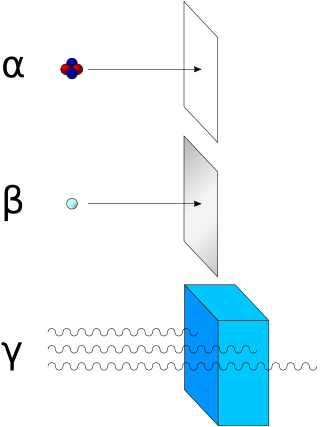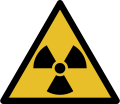शीर्ष प्रश्न
समयरेखा
चैट
परिप्रेक्ष्य
रेडियोसक्रियता
विकिपीडिया से, मुक्त विश्वकोश
Remove ads
रेडियोसक्रियता (रेडियोऐक्टिविटी / radioactivity) या रेडियोधर्मिता वह प्रकिया होती है जिसमें एक अस्थिर परमाणु अपने नाभिक (न्यूक्लियस) से आयनकारी विकिरण (ionizing radiation) के रूप में ऊर्जा फेंकता है। ऐसे पदार्थ जो स्वयं ही ऐसी ऊर्जा निकालते हों विकिरणशील या रेडियोधर्मी (रेडियोऐक्टिव) कहलाते हैं। यह विकिरण अल्फा कण (alpha particles), बीटा कण (beta particle), गामा किरण (gamma rays) और इलेक्ट्रॉनों के रूप में होती है।[1]
- रेडियोधर्मिता (रेडियोऐक्टिविटी) के अन्य प्रयोगों के लिये रेडियोधर्मिता (बहुविकल्पी) देखें

Remove ads
इतिहास
रेडियोसक्रियता की खोज फ्राँस के वैज्ञानिक हेनरी बेक्वेरल ने 1896 में की थी। यदि यह क्रिया स्वतः होती है, तो इसे प्राकृतिक रेडियो सक्रियता कहते हैं, जबकि मनुष्य के द्वारा करा जाने पर कृत्रिम रेडियो सक्रिता कही जाती है। प्राकृतिक रेडियोसक्रियता मुख्यतः भारी नाभिकों से होती है। यूरेनियम (परमाणु संख्या 92) पहला खोजा गया प्राकृतिक रेडियोसक्रिय तत्व है।[2]
रेडियोसक्रिय समस्थानिकों के उदाहरण
प्राकृतिक समस्थानिक
कृत्रिम समस्थानिक
विभिन्न प्रकार के क्षय
सारांश
परिप्रेक्ष्य
यद्यपि पहले केवल अल्फा, बीटा और गामा विकिरण की ही खोज हुई थी, किन्तु बाद में पता चला कि कै अन्य प्रकार के उत्सर्जन (emission) भी होते हैं।
Remove ads
रेडियोसक्रियता से सम्बन्धित खतरे के चिह्न
- The trefoil symbol used to indicate ionising radiation.
- 2007 ISO radioactivity danger symbol intended for IAEA Category 1, 2 and 3 sources defined as dangerous sources capable of death or serious injury.[3]
- The dangerous goods transport classification sign for radioactive materials
रेडियोसक्रिय तत्व

इन्हें भी देखें
- विकिरण सुरक्षा (radiation protection)
- आयनकारी विकिरण (ionizing radiation)
- अर्धायु काल (half life period)
सन्दर्भ
Wikiwand - on
Seamless Wikipedia browsing. On steroids.
Remove ads



